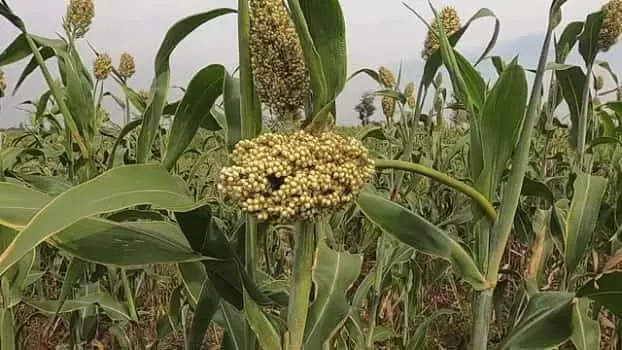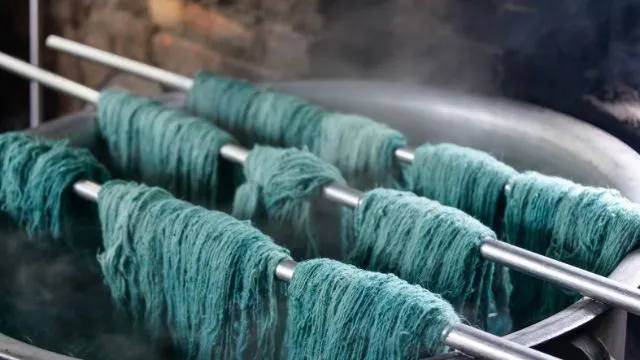Jowar, widely called Sorghum, is the 4th essential food grain of India and is one of the leading cereal crops in the world. Millions of poor rural people living in African and Asian countries depend on this staple food. In addition to being a vital source of staple food for people, Jowar also serves as an essential source of animal feed, fodder, and industrial raw material. It was cultivated in an area of 43707.4 thousand hectares in the world during the year 2005, which produced about 59197.52 thousand tonnes of food grains.
One Indian state named Maharashtra spotted the highest position in the production of Jowar with 3.90 million tonnes of production with 51.11% from 2005 to 2006. During 2011 to 2012, the renowned Jowar-producing states of India were Karnataka, Maharashtra, Madhya Pradesh, and Andhra Pradesh.
In Maharashtra, few regions entirely rely on the Jowar production because it is the primary source of livelihood. Karnataka is the 2nd largest producer of Jowar about 18.51% of the overall production while Gujarat and Rajasthan is the least production region in India.

Importance of Jowar in India
Jowar holds a pivotal role in India, serving as a nutritional, agricultural, and cultural cornerstone. It is becoming famous as the new quinoa due to its whole grain health benefits and gluten-free nature. It can be produced as both Rabi and Kharif crops. Also called cholam, jonna, jowar, bhakri, rotis, dosa, cheela, etc. are used in many food products by adding to the flour. Economically, it bolsters rural communities and supports livestock farming. Due to its health benefits and new trends like people living a healthy lifestyle, it is gaining immense popularity in recent years. It aids in digestion and is good for weight loss.
Jowar Production in the Indian States
| Ranking | Name of State | Share in % | Production in Tonnes |
| 1. | Maharashtra | 37.88 | 1,807,51 |
| 2. | Karnataka | 20.68 | 986,98 |
| 3. | Tamil Nadu | 10.90 | 520.07 |
| 4. | Rajasthan | 9.55 | 455.77 |
| 5. | Andhra Pradesh | 8.15 | 389.11 |
| 6. | Uttar Pradesh | 4.75 | 226.63 |
| 7. | Madhya Pradesh | 3.46 | 165.13 |
| 8. | Telangana | 2.60 | 123.86 |
| 9. | Gujarat | 1.41 | 67.16 |
| 10. | Haryana | 0.33 | 15.79 |
List of The Largest Jowar Producing States in India
1. Maharashtra
Maharashtra as compared to all other states produces more than 54% of the total Jowar production in India. Even though 22 districts of Maharashtra produce Jowar, Parbhani, Kolhapur, Nanded, Osmanabad, Amravati, and Ahmednagar are the major producing districts. Jowar is the staple food of the plateau region living in Maharashtra. In some districts to the south of Pune, 80% of the cultivation is dedicated to Jowar. The production of Jowar is usually more than 2 meters long and is used as feed for the cattle.
2. Karnataka
Karnataka is the second largest Jowar-producing state in India with 20.68% of total production. It is widely produced in the northeastern regions of the Karnataka plateau. Karnataka’s around 80% of production comes from Gulbarga, Raichur, Bijapur, Dharwar, Bidar, Belgaum, and Chitradurga districts. The state affects by a low yield of only 7.4 Hectares against the National Average of 7.7 Quintals, but it can be enhanced by increasing the yields.
3. Tamil Nadu
In Tamil Nadu, Jowar is the 2nd most vital food crop after rice. The production of Jowar in the state mostly comes from Madurai, Tiruchirapalli, and Dharmapuri districts. Some western parts of Uttar Pradesh grow it as fodder.
4. Rajasthan
Rajasthan’s sandy soil and dry climate offer good conditions for the production of Jowar. Some of the common districts of Rajasthan where Jowar comes from include Jaipur, Tonk, Sawai Madhopur, Kota, etc. However, the state suffers from the issue of extremely low yields which is one of the lowest in India.
5. Andhra Pradesh
In the past few years, Andhra Pradesh has faced a reduction in the production of Jowar. Some of the important Jowar-producing districts of AP are Nalgonda, Cuddapah, Adilabad, Khammam, Medak, Anantapur, Kurnool Mahbubnagar, etc.
6. Uttar Pradesh
UP has accounted total Jowar production of 220 Tonnes from year 2017 to 2018. It has managed to distribute 4.44% of its share to a country in Jowar. Uttar Pradesh has remained in the limelight and is also famous for the variety of other crops.
7. Madhya Pradesh
The staple grains like Jowar and Bajra are cultivated in some districts of Madhya Pradesh, with the northern districts of Gwalior, Morena, Bhind, Sheopur, and Datia, followed by districts like Hoshangabad, Narsinghpur, Harda, and Sehore. It is the other largest producer but lags far behind Maharashtra.
8. Telangana
Jowar is an essential Rabi season crop produced in around 1.20 Lakh acres of land across the state. Here cultivated Jowar is used for fodder animal feed, human consumption, and the production of adhesive, starch, paper, etc.
9. Gujarat
Jowar in Gujarat is also grown as fodder in Mehsana, Surat, Bharuch, Tapi, Junagadh, and Vadodara districts. The coastal district of Porbandar accounts for about 75 percent of the jowar sown so far across Gujarat. The region alone has accounted for more than 24,600 hectares of sowing, which is more than twice the area sown last year around 9,000 hectares. According to the State’s Agriculture Department, Jowar is the only crop to have crossed 100% sowing as of December 10, 2018.
10. Haryana
Haryana contributes the 2nd highest amount of food grains to India’s central grain pool and is self-sufficient in food production. In the financial year 2020, over one million metric tons of maize, millets, and sorghum were cultivated in the northern state of Haryana.
Conclusion
Jowar is both a fooder and a food crop that grows mainly in arid regions. It is a whole grain crop that has the distinction of being the 5th most essential cereal crop in the world. Maharashtra accounts for about 50% of India’s total jowar production and the top major states of this crop in India include Maharashtra, Andhra Pradesh, Tamil Nadu, and Karnataka.
Jowar Producing India FAQs
Q: Which states in India are known for jowar production?
Ans: Jowar is grown in several states across India. Some of the prominent jowar-producing states include Maharashtra, Karnataka, Andhra Pradesh, Telangana, Madhya Pradesh, Gujarat, Rajasthan, and Tamil Nadu.
Q: What are the different varieties of jowar grown in India?
Ans: There are several varieties of jowar cultivated in India. Some of the common varieties include Maldandi, Jowar 111, Chari, Phule Chitra, CSH 16, and CSH 20.
Q: What are the climatic conditions required for jowar cultivation?
Ans: Jowar is a crop that can tolerate a wide range of climatic conditions. However, it thrives well in tropical and subtropical regions. It requires a moderate temperature ranging from 25°C to 32°C and an average rainfall of 400-600 mm.
Q: When is the sowing season for jowar in India?
Ans: The sowing season for jowar in India varies based on the region and prevailing climatic conditions. In most parts of the country, the ideal time for jowar sowing is during the monsoon season, which is typically between June and July.
Q: How is jowar cultivated in India?
Ans: Jowar cultivation involves several steps. It starts with land preparation, where the soil is plowed and leveled. Then, seeds are sown either by broadcasting or through drill sowing methods. After sowing, the crop is irrigated and weeded periodically. Jowar plants usually mature within 3 to 4 months and are ready for harvesting.
Q: What are the major pests and diseases that affect jowar crops in India?
Ans: Jowar crops in India can be affected by various pests and diseases. Some common pests include shoot fly, stem borer, armyworms, and aphids. As for diseases, jowar can be susceptible to ergot, leaf blight, downy mildew, and grain mold.
Q: What are the uses of jowar in India?
Ans: Jowar has multiple uses in India. It is primarily consumed as a staple food, where it is ground into flour to make rotis (flatbreads), bhakris, or porridge. Jowar is also used in the production of alcoholic beverages, animal feed, and as a raw material in the manufacturing of various industrial products like adhesives and paper.
Q: Is jowar considered a nutritious grain?
Ans: Yes, jowar is highly nutritious and offers various health benefits. It is rich in dietary fiber, protein, and essential minerals like phosphorus, potassium, and iron. Jowar is gluten-free, making it a suitable option for individuals with gluten sensitivities or celiac disease.
Q: What is the export scenario for jowar from India?
Ans: India exports jowar to several countries around the world. Some of the major export destinations for Indian jowar include the United States, Mexico, Japan, the United Arab Emirates, and various African countries. Jowar exports contribute to the agricultural export earnings of the country.

Santosh Kumar is an editor at unfoldstuffs.com and a professional content writer. With years of experience he is passionate for creating engaging, informative and impactful topics.









